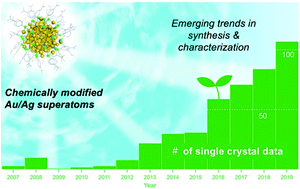Ligand-protected gold/silver superatoms: current status and emerging trends
Abstract
Monolayer-protected gold/silver clusters have attracted much interest as nano-scale building units for novel functional materials owing to their nonbulk-like structures and size-specific properties. They can be viewed as ligand-protected superatoms because their magic stabilities and fundamental properties are well explained in the framework of the jellium model. In the last decade, the number of ligand-protected superatoms with atomically-defined structures has been increasing rapidly thanks to the well-established synthesis and structural determination by X-ray crystallography. This perspective summarizes the current status and emerging trends in synthesis and characterization of superatoms. The topics related to synthesis include (1) development of targeted synthesis based on transformation, (2) enhancement of robustness and synthetic yield for practical applications, and (3) development of controlled fusion and assembly of well-defined superatoms to create new properties. New characterization approaches are also introduced such as (1) mass spectrometry and laser spectroscopies in the gas phase, (2) determination of static and dynamic structures, and (3) computational analysis by machine learning. Finally, future challenges and prospects are discussed for further promotion and development of materials science of superatoms.



 Please wait while we load your content...
Please wait while we load your content...